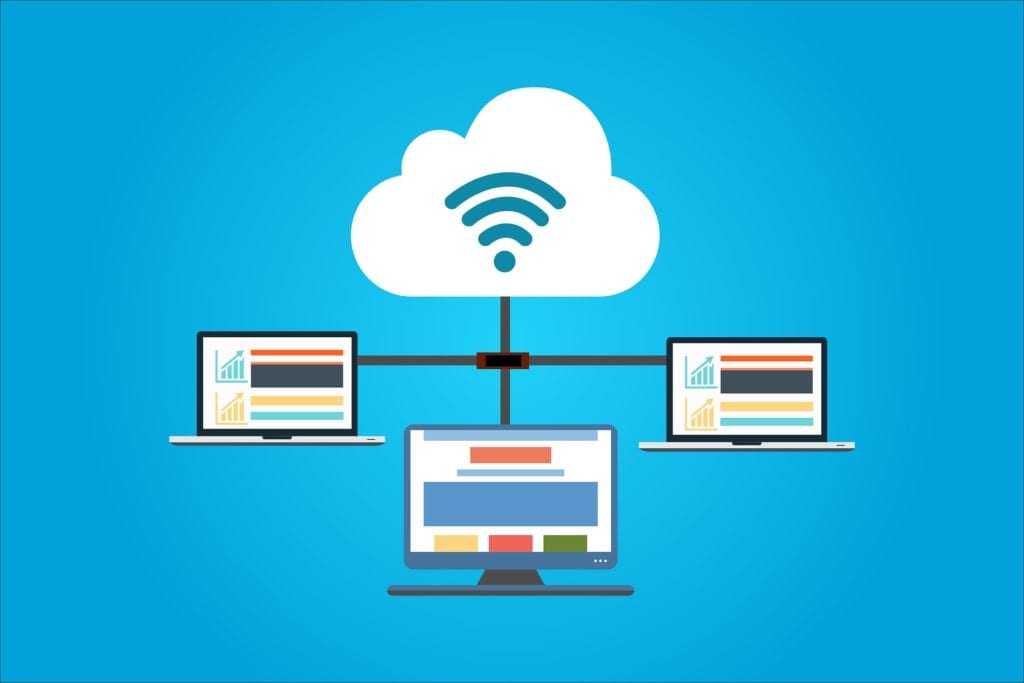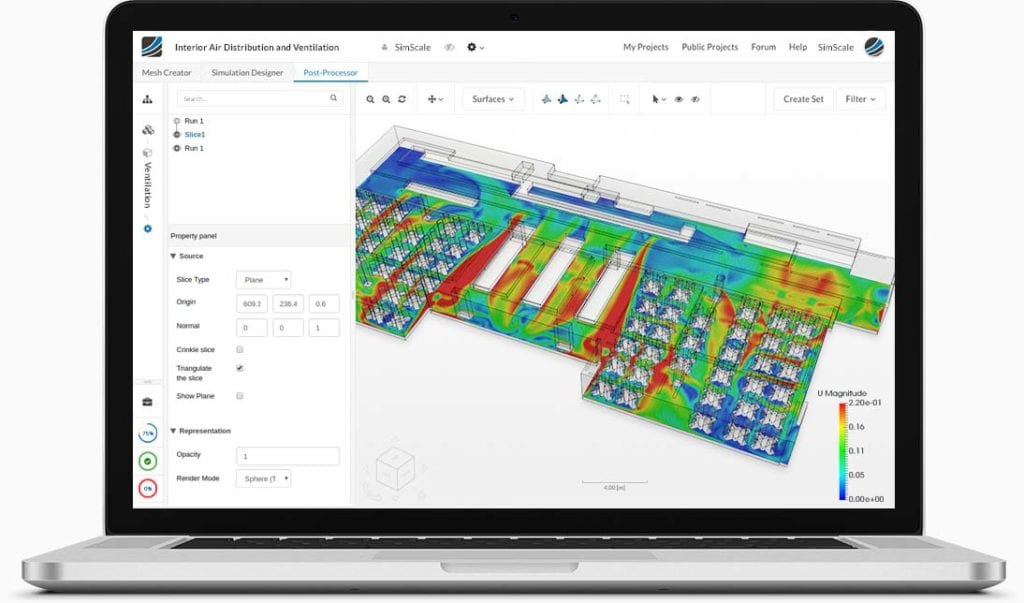Beyond sophisticated scientific analysis methods like computational fluid dynamics (CFD) and technological paradigm shifts that beg questions like ‘where will the future of cloud computing take us?’, humankind’s most impressive achievements to date boil down to one recurring human trait: curiosity. Think about it, our species has progressed to this point in time for chiefly two reasons; survival instincts and curiosity. This latter quality is the differentiating factor between simply surviving and living, the driving insatiable evolutionary instinct to acquire knowledge and skill.
Much like human evolution, characterized by changing the inherited means of growth and development that typify a population, the same is true for the evolution of scientific disciplines and human processes through technology, such as computing, computation, and numerical analysis.
The Evolution of the Cloud
Cloud computing was born, so to speak, in 1963 at MIT when their team of computer scientists were tasked with making a computer usable by two or more people, simultaneously. With the help of two million dollars in funding for Project MAC, the first ‘Cloud’ in the now saturated cloudy horizon appeared.
The subsequent evolution of cloud computing can maybe be best described by Professor Ramnath Chellapa of Emory University from back in 1977, when he stated that it was a new, “computing paradigm, where the boundaries of computing will be determined by economic rationale, rather than technical limits alone”. Nowadays, almost every enterprise uses the cloud in some capacity, and Forbes has even gone as far as to track the top 100 cloud companies.
No longer can engineering teams be bound by project silos, time zones, or physical locations to meet demanding deadlines. So how can engineers use this to their advantage?
The Evolution of CFD
Computational fluid dynamics (CFD) was a result of scientific evolution resulting from curiosity to see, understand, and evaluate the effects of different fluid flows. CFD is the branch of fluid mechanics that makes use of computers to analyze the behavior of fluids and physical systems. CFD analysis became a popular solution as the complexity grew in applying the laws of physics directly to real-life scenarios in order to make analytical predictions. This fact became especially prevalent for fluid dynamics and heat transfer engineering problems.

Yet, that’s not to say this methodology hasn’t been through trial and error along the way much like it is argued that trial and error affected the evolution of animal cognitive capacities. Over time, CFD has matured as a discipline. In this article, we will explore this engineering process from early days, to the beginnings of computational fluid dynamics, to modern-day CFD software, and finally what the future holds while in conjunction with the equally unknown future of cloud computing.
Before CFD: Real-World Simulation
Before there was computer science and computation, there was simply pen to paper and hand-drawn calculations. The first hydro calculation was described in a Los Alamos report on June 20, 1944. In this story, American theoretical physicist Richard Phillips Feynman was the calculational lead and marked the transition from human computers to IBM machines; one small step for mankind, one large step towards CFD as we know it today.
Wind Tunnel Testing: Then and Now
In the same stroke but on different playing fields, wind tunnel testing was also making scientific strides. The earliest wind tunnels can be dated towards the latter 19th century, and their existence credited to early aeronautic research. These real-life simulation devices were created in an attempt to reverse the usual paradigm: instead of static air allowing an object to move through it, wind tunnels reversed this so that engineers could observe and measure the aerodynamic forces being imposed on it.

The development of wind tunnels parallelled the development of the airplane. The aerospace industry was the first to adopt this method of evaluation, as wind tunnels began being built and widely used during World War II. It wasn’t until years later that engineers realized wind tunnel testing could be used for other applications; namely buildings and planned structures. Determining such forces upon buildings was practiced via wind tunnels before codes and standards could specify the required strength and parameters needed, such as ASCE 7.
Wind tunnel testing soon expanded to the automotive industry where it was then used to determine aerodynamic forces. In some cases, moving belts under the test vehicle were placed in an effort to approximate the actual condition and make the results as valid as possible. This method was very similar to that used for wind tunnel testing of aircraft take-off and landing configurations.

Various industries as well as even more niche sporting industries soon became common practitioners of wind tunnel testing, to evaluate new products in the design phase such as golf clubs, surfboards, Olympic bobsleds, cyclists, and race car helmets. But for smaller businesses and industries that didn’t see the value in spending so much on this type of evaluation, they began to look elsewhere; and that’s where the digitization of wind tunnels began to take form.
What Wind Tunnels Were Missing: CFD
The sole use of wind tunnels for product design evaluation was seen as too resource-dependent by many—from prototyping the design in question to the actual materials and space needed to create such a large wind device, ultimately not giving engineers the whole picture. To date, there is no wind tunnel that can test the size of a full passenger air vessel, despite tunnels ranging in size and testing everything from large-scale models of airplanes and other aerospace vehicles to small-scale prototypes and replicas. So, how could wind tunnel testing be improved upon to handle larger models, give more holistic results, and utilize fewer resources? The curiosity around how to solve this dilemma led engineers to computer-based evaluation methods; namely CFD.
Advances in computation and computational fluid dynamics (CFD) allowed engineers to model and evaluate their designs on high-speed digital computers. CFD is, of course, still used as an additional analysis tool and not a replacement for wind tunnels, but it certainly helps decrease costs and verify predictions. Until the end of the 20th century, CFD was typically a tool used solely in academic environments or large aerospace companies. Back then, CFD was a very expensive and time-consuming activity. Let’s take a look at the early life of CFD.
This paper addresses the difference between on-premises software and SaaS
solutions for computer-aided engineering, explaining how SaaS came to be and its
key benefits.
Early CFD: Desktops, Data, and a Desire for More…
The evolutionary track of CFD evaluation method was first developed to solve the linearized potential equations, introduced two-dimensional (2D) methods in the 1930s, propelled by Feynmann’s aforementioned discovery, and to finally encompass 3D methods in the 1980s. Today, CFD can be seen as a group of computational methodologies that encompasses the earlier methodologies and works to decide which set of physical assumptions and related equations need to be used for the particular problem at hand.
On a more technical level, there are two dominant approaches to CFD—finite-difference and finite-volume or -element formulations. In both cases, CFD involves discretizing the spatial domain into a grid or mesh of points or elements, and marching the numerical solution forward in discrete time steps. Depending on the flow conditions, different approaches to discretization and time-marching may be favored on an application-specific basis.
CFD Hardware
When this highly technical methodology was first adopted, engineering teams would run CFD simulations on one or more large computers in a lab or office, where the entire hard drive was dedicated just to running these evaluations. Not only did these machines take up physical space within the workplace, they took up an abundance of space within local hardware and servers. This meant that each device needed to receive manual updates, installations, and regularly scheduled maintenance. For small startups, firms, and enterprises this was almost impossible to run and maintain, as well as started to be outdated as other technological advances carried on ahead.

CFD No Longer Chained to a Desktop
Jumping to this implementation in modern-day scientific evaluation, there are a plethora of CFD software offerings on the market, that vary from general purpose with many capabilities to tailored tools for specific applications. Many firms even develop their own in-house codes for specific ad hoc engineering tasks.

Yet, as mentioned in the above section, who has time, money, or space for traditional desktop-based CFD in today’s fast-paced world? This is where the cloud comes in. Cloud-based simulation platforms and computer-aided engineering (CAE) tools like Onshape and SimScale, are being increasingly adopted based on their ability to provide an easy workflow, a modern user interface ran from the web browser with computation offloaded to remote servers that scale as needed and require no maintenance.
CFD Heads Towards the Cloud
Recently, cloud-based CAE and CFD software have both pushed the boundaries for more complex or faster simulations, as well as collaboration and efficiency in the design workflow. Dedicated, fixed-cost high-performance systems are often not economical for small-to-medium enterprises (SMEs), considering the cost for hardware, physical space, power, and maintenance. This gap in the market opened the door to SaaS and CFD through cloud computing.
Cloud-Based CFD: The Current Climate
Cloud computing means using online compute resources or services, with reduced or non-existent effort to configure, maintain, and scale them to your varying needs. This goes from simple services like storage to much more complex products and applications, with more profound implications. How about never installing or updating software again? That’s right, this is a thing of the past if you use software as a service (SaaS). Such software is often operated by a software vendor on a large public cloud – but who runs those? Let’s look at the current cloud market landscape.

The Current Cloud Market
The public cloud market has long been seen as a race among three champions of the Cloud, with little sign of Amazon Web Services’ (AWS) dominance sliding, or a fourth vendor breaking into action. The actual figures are difficult to ascertain in the public cloud market as each vendor breaks out their numbers differently, but Synergy Research estimates that AWS is the clear market leader with around 40 percent market share, followed by Microsoft Azure at 30 percent and Google Cloud at 10 percent. So what does this mean for cloud-based engineering software like CFD?
Cloud-Based Simulation
About 5 years ago, Dr. Marc Halpern spoke at the NAFEMS annual North America conference, stating the “cloud is central to everything“. Dr. Halpern is vice president of research at Gartner and one of the earliest pioneers of CAE as one of the earliest developers of ANSYS. Although cloud-based engineering software applications are really nothing new anymore, there has been a definite uptick in what’s available online over the past couple of years. For example, there are cloud-based systems for computer-aided design (CAD), rendering/visualization, product data management (PDM), product lifecycle management (PLM), enterprise resource planning (ERP), manufacturing execution systems (MES), and simulation.

Specifically, simulation is a natural fit as a cloud-based application because it can be computationally intense, requiring a lot of computing horsepower. Instead of incurring the cost and burden of expensive desktop workstations doing the heavy lifting, for an increasing number of organizations, cloud-based simulation makes a lot more sense, as well as sitting first row to see what the future of cloud computing will bring.
As CFD developed, it had only been associated with high-performance computing (HPC). For decades, only a few players dominated the market and the use of CFD has been limited to big-budget projects, requiring software licenses and in-house HPC hardware. Until curiosity led to the emergence of cloud-based CFD. By leveraging HPC cloud services, SaaS packages eliminate the high upfront costs previously associated with simulation.
What Is SaaS?
Software as a service (SaaS) is a software licensing and delivery model in which software is licensed on a subscription basis and is centrally hosted. Just as for other cloud services, benefits such usability, cost-efficiency, no maintenance requirements, and easy integration with other products have driven the adoption of the software-as-a-service model. It is sometimes referred to as “on-demand software,” and was formerly referred to as “software plus services” by Microsoft. Back in 2018, Gartner estimated that SaaS sales were expected to grow 23% to $72 billion, and by end of 2020, it is predicted that 85% of small businesses have invested in SaaS solutions of some kind, waiting to see what the future of cloud computing will bring.
SaaS, the Cloud and CFD
SaaS apps are typically accessed by users via a web browser. SaaS has become a common delivery model for many business applications, including office software, messaging software, payroll processing software, parts of the software development toolchain software, management software, CAD software, development software, etc. SaaS has been incorporated into the strategy of nearly all leading enterprise software companies.
Besides eliminating the need for users to invest in their own HPC resources, cloud-based SaaS solutions for CAE use a simple subscription model that eliminates the complications of traditional on-premises software licensing and maintenance. Looking at CAE tools specifically, SimScale is the world’s first production-ready SaaS application for engineering simulation, from CFD to FEA and even thermodynamic simulation. SimScale’s cloud-based fluid dynamics software enables you to test, validate, and optimize your designs through online CFD, harnessing the power of the cloud.

So now that we’ve established where CFD and the cloud came from, how they’ve integrated in the form of SaaS applications, and what the benefits are, what could possibly be next for the CAE industry?
CFD of the Future: Complexity and Increasing Cloud Use
So where will CFD go from here? Already in the cloud, surely it’s reaching for the stars? Well, because I, like many of you, cannot predict the future, I can only hedge my bets. Based on the available data, it looks like computational fluid dynamics can only go onwards and upwards. I think it can be said with some degree of certainty that resource-draining hardware applications will become less and less relevant, non-environmentally-friendly and uneconomical processes of the past.
Predictions for the Future of Cloud Computing and Cloud-Based CFD
I’m sure we’ll see an increase in CAD complexity, and other CAE software like Onshape will be ready for this change. I think it can be predicted that AWS will continue to be the front runner for cloud services, but with a greater focus on security. Last year, Nick McQuire, VP and head of enterprise and AI research at CSS Insights, notes “Some of the biggest cloud deals we have seen [in 2019] have been with enterprises that have nominated a preferred cloud partner because they are deploying both cloud productivity and collaboration applications alongside their infrastructure services.” illuminating the rise in popularity of collaboration based cloud tools, and hinting at the future of cloud computing.

According to Gartner, the IaaS and SaaS market is growing worldwide year-on-year, so you’re likely to see budgets rise. The current cloud trend is going towards cloud management systems that give a broader holistic view of activity and costs, as well as help managers optimize their operations. I think this can be translated in the same respect to the CAE and CFD market, and online simulation as a whole as tools with team licenses and collaboration features are becoming a more widespread need.
If I were to take an educated guess, I would say that CFD software will follow suit of cloud-management systems; optimizing costs, giving more visibility into work and workflows, facilitating collaboration, improving data security, and, of course, giving end-users what they need (CFD results) faster and more visually stunning than ever before. Who can predict what the future of cloud computing may hold? But I think it is safe to say it is here to stay.





